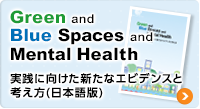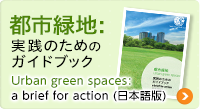Q&A at World Urban Parks Japan International Symposium 2021
2021/07/28IFPRA Japan 30th Anniversary & World Urban Parks Japan 5th Anniversary
World Urban Parks Japan International Symposium 2021
-The Role of Open Spaces to Enrich Our Life in “New Normal”-
Here are the answers by the speakers and those who participated in Panel Discussion to the questions that were asked by participants during the symposium.
【Q1】
Does that concept of people and nature exist in Japanese culture and does that provide opportunities for creating more liveable cities?
【A1】
Japanese culture has been pervaded by ideas and skills for creating a society that coexists with nature, simultaneously receiving its gifts and enriching the environment. However, with the rise of urban development Japanese people have forgotten their historical connection to nature. With the loss of local ecosystems, the cultural legacies developed through ordinary engagements with nature will also be lost.
The Covid-19 pandemic has provided us with an opportunity to reflect on our declining connection to nature and culture amid our urban lifestyles, and to question whether we are truly living in comfortable cities. Through our efforts to utilise natural environments for developing connections between humans and nature, and among people as well, we can firmly conclude that more and more people are interested in taking part in such activities, especially following the pandemic. I would like to revive our cultural legacies that had enriched our lives in close connection with nature, through utilising accessible natural areas and urban parks, in ways that suit the present age.
(Rumi Sato)
【Q2】
Is having a connection with nature an important concept in both the Pittsburgh model and the National Park City concept?
【A2-1】
Yes, creating more nature and more opportunities to connect to nature are at the heart of the National Park City concept. Making the city greener and wilder are two of three core purposes.
(Dan Raven-Ellison)
【A2-2】
Having a connection with nature is a very important concept and is the foundation of the Pittsburgh model and the National Park City concept. The Pittsburgh model and the National Park City concept are based on improving access to and the quality of parks and nature.
(Jayne Miller)
【Q3】
1) Is National Park City initiative any difference from Garden City Movement.
2) How does this NPC fit into the overall physical planning structure of a city.
3) In most developing countries like Malaysia, we are having a hierachy of structuted open spaces standards such as National parks, state parks, federal parks, city parks, local parks and neighborhood parks. How do you fit NPC initiative into this frame work.
【A3】
1)
There are similarities, but the Garden City Movement is more about new developments and influence through planning. Some of the aims, like making cities greener, are similar… but none of the current National Park City campaigns are in garden cities. Instead they are working with people to weave nature into the city in as many ways as possible – across different sectors and areas of interest.
2)
This will happen differently in different National Park Cities. In the case of London, the National Park City is a point of inspiration and influence, but it is not a planning authority. The Mayor of London who looks after planning in the city does mention the London National Park City in the master plan for planning in London and this is linked to targets of making the city greener – but there is not an explicit National Park City delivery strategy from the Mayor’s planning team. This could change in the future or work differently in other cities.
Other than top-down planning policy, the London National Park City does have a “Development Forum” which includes about 30 of London’s largest developers. This forum is actively working with developers to encourage the spread of National Park City ideas and values in their work.
Personally, I’m interested in how the National Park City will shape imaginations, policies and developments in the longer term. As children grow up learning about the National Park City they live in – how might that shape their decisions as architects, designers, planners or politicians?
3)
It would be great to have a conversation about this, as I do not have a good understading of the system. In terms of size and importance, it may be that a National Park City would simply be siblings of your National Parks.
(Dan Raven-Ellison)
【Q4】
I could understand the described role of park coordinators as mediating the relationship between private and public sectors to make local needs visible for citizens and communities and realize goals together. However, to activate parks, I also think such intermediary organizations are not necessarily required if citizens and authorities can solve such gaps directly or build common language or consciousness together. I believe the latter would be the ideal situation. If we introduce intermediary organizations in addition to the existing system of designated park managers, the whole management system will become heavily complex. What do you think are the barriers that prevent neighbors from directly cooperating with local authorities? And any idea for a breakthrough in this issue?
【A4】
If there is no longer a gap between private and public sectors, or if they establish a common language or shared awareness, I believe they can begin communicating with each other (1). Yet, to concretely advance cooperation and collaboration a further condition is necessary. This is the expertise required to realize ideas into actual projects, in other words, the art of total management that involves looking after various matters, such as planning, operation and safety measures, from a collaborative perspective (2).
Speaking of (1) first, I certainly hope this would happen, yet I also feel it is something difficult to realize. As discussed during my presentation, I have reached the aforementioned conclusion after having struggled with this challenge for almost 30 years.
The difficulty lies in the fact that the so-called “public sector” comprises individual actors who are in fact diverse in their knowledge and experience, and who change their job responsibilities once every few years [a characteristic of Japanese workplaces]. The category of so-called “citizens” also includes a wide range of individuals with different ways of thinking, knowledge and experiences, hence the need for coordination among them as well. I would say that through intermediating (translating) the different voices in order to help accomplish the goals set out in the collaborative process, for the past 15 years our practice has demonstrated the remarkable usefulness of a third party who possesses expertise in both collaborative projects and the conservation and utilization of green space.
Of course, I do not mean to deny the possibility of there being successful cases not involving systematic intervention by such a third party. However, the success of such cases often hinges on the coordinating skills of specific individual actors within the public sector or among citizens. Therefore, the continuity of the process becomes threatened when such individuals in the public sector move to another department, or when an influential citizen stops their activities due to aging (since their activities are voluntary and unpaid, it is very difficult to find new people who would voluntarily undertake their efforts, especially today).
With regards to (2), the expertise to turn ideas into concrete projects is fundamental for advancing projects in the context of parks, which are public facilities. As far as I can see, not many people in the public sector and citizen communities have the knowledge and experience of the risks, conditions and frameworks necessary for managing projects in actual park settings. Time to time, we encounter news reports of fatal accidents at park events, and appropriate risk management is essential to prevent such tragedies.
I believe that amid the ongoing trend of population decline, the question of becoming a “city of choice” [where people desire to live/move] depends on how local authorities manage urban greenery. It requires a lot of energy to change existing systems, but the introduction of such new institutional frameworks will undoubtedly reshape parks and local communities over the next five to ten years.
(Rumi Sato)
【Q5】
The elderly population is expected to grow in size in the future, and I think parks and open spaces are useful for preventing issues like dementia, isolation and social withdrawal because they offer spaces to exercise casually and communicate with others. What do you think about this possibility? In order to encourage people to visit parks on a regular basis, I suppose that the employment of recreation coordinators and fitness instructors [Kenkou Undou Shidou Shi] would be helpful; and if regular users can demonstrate positive long-term outcomes in their fitness level, I think it would be effective to cover the associated costs through the [national] health insurance. I would like to hear your opinion.
【A5】
In Japanese urban parks, there are already programs that encourage visitors to exercise and to enjoy nature and forest bathing. These programs can promote both mental and physical health, help people socialise through group activities, and in some cases they also provide direct or indirect employment opportunities.
In the UK and other European countries, there exists an initiative called “social prescribing,” in which the wellbeing of citizens is promoted through non-medical approaches prior to needing medical services. Considering the contents of this approach, it is evidently not very different from the programs provided in Japanese parks. However, there is a divergence from similar efforts in Japan in terms of the existence of awareness of their effects and influence. The London Assembly defines social prescribing as “social prescribing is where people receive non-medical help to improve their health and well-being” and considers participation in local community activities the primary means of implementation. According to the data collected in London, this effort has reduced the annual cost of medical care by an equivalent of 150 billion yen. I believe parks are the ideal places for assisting the urban population in improving their health and well-being independently, without making them heavily dependent on medicine.
The “social prescribing” approach emphasises coordination among people, a role that has been established as a profession. A person in this capacity is called a “link worker,” which is similar to park coordinators in Japan. There are also examples of the deliberate deployment of non-medical services to improve people’s health and well-being, including “health rangers” in the state of Victoria, Australia and “park trainers” in Japan.
Reference: Neil McCarthy, Leadership in Action: A Strategic Approach to Healthy Parks Healthy Cities – Lessons from Japan, World Urban Parks-Newsletter, May 2019.
As you pointed out in your question, discussions have begun in Japan as well regarding the feasibility of utilising the premium of health insurance associations or implementing incentive systems within life insurance to fund these activities. I expect that welfare expenses of wellbeing-oriented companies could also become a funding source.
(Ryu Ono)
【Q6】
I am interested in your vision and activities of National Park City, as well as in the social trends towards more proactive engagement with parks and nature. How do you think the national and ethnic legacies of gardening, such as its histories, ideas and methods, can be related to these contemporary activities and social trends?
Also, I want to ask this question specifically to Mr. Dan Raven Ellison: Have you made special efforts to advance the National Park City movement? For example, I suppose this may require further development of existing practices regarding municipal management systems for plants, as well as the education of gardening experts to enhance their specialties and skills. I work as a professional gardener in Tokyo.
【A6】
Awaiting an answer.




